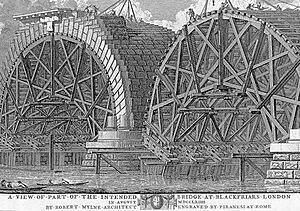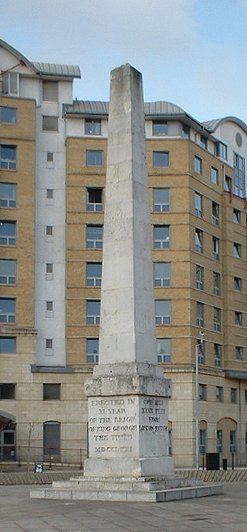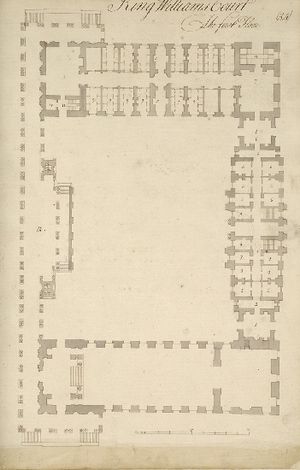Robert Mylne (architect) facts for kids
Quick facts for kids
Robert Mylne
|
|
|---|---|

Engraving of Mylne, aged 24, by Vincenzio Vangelisti, after a drawing by Richard Brompton.
|
|
| Born | 4 January 1733 Edinburgh
|
| Died | 5 May 1811 (aged 78) New River Head, Clerkenwell, London
|
| Nationality | Scottish |
| Occupation | Architect |
| Awards | Concorso Clementino, Accademia di San Luca, Rome |
| Buildings | Blackfriars Bridge, London The Wick, Richmond Tusmore House, Oxfordshire |
| Projects | Inveraray new town, Argyll |
Robert Mylne (born January 4, 1733 – died May 5, 1811) was a Scottish architect and engineer. He is best known for designing Blackfriars Bridge in London.
Mylne grew up in Edinburgh, Scotland. As a young man, he traveled to Europe to study architecture. He learned from the famous artist Piranesi in Rome. In 1758, he became the first British person to win a major architecture competition in Rome. This made him well-known in London. It also started a friendly rivalry with another Scottish architect, Robert Adam.
When Mylne returned to Britain, he won the contest to design the new Blackfriars Bridge over the River Thames. His design was chosen over those of older, more experienced engineers. He also became the main surveyor for the New River Company. This company supplied drinking water to London. He was also in charge of keeping St Paul's Cathedral in good repair. He held both these important jobs for his entire life.
Mylne designed many country houses and city buildings. He also designed more bridges. As he got older, he focused more on engineering. He wrote reports about harbors and gave advice on canals. He was also asked to share his expert opinion in court cases.
Mylne helped start the Smeatonian Society of Civil Engineers. This was the world's first engineering society, created in 1771. He also helped create the Architects' Club. He often spent time with important doctors, thinkers, and scientists. Mylne was known for being quick-tempered but also very honest. He always felt it was his duty to do things right. He could be stubborn when he believed he was correct. This sometimes made him unpopular, especially when many people were not as honest. He passed away at age 78 and was buried in St Paul's Cathedral. There is a special memorial for him there.
Contents
Becoming an Architect and Engineer
Robert Mylne came from a family of builders and architects. His great-grandfather, also named Robert Mylne, was famous. He worked as the King's Master Builder at Holyrood Palace in Edinburgh.
The younger Robert was born in Edinburgh. His father, Thomas Mylne, was the city's surveyor. He was also a leader in the main group of stonemasons in Edinburgh. Robert went to the Royal High School from age nine to fourteen. After that, he became an apprentice to a carpenter for six years. An apprentice learns a trade by working for an expert. During this time, he likely also learned stonemasonry from his father. He worked for the Duke of Atholl at Blair Castle. People expected him to take over his family's building business.
Studying in Europe
In 1754, Mylne began a "Grand Tour" of Europe. This was a trip many young, wealthy men took to learn about art and architecture. He joined his brother William, who was studying in Paris. They traveled through France, often walking or going by boat. They visited Avignon and Marseille. From there, they sailed to Italy.
They arrived in Rome in January 1755. They met other Scots living there, including Robert Adam. Adam was another architect who saw Mylne as a possible rival. He noted that Mylne "begins to draw extremely well." The Mylne brothers often had little money. Their father sent them only £45 a year. In comparison, Adam spent about £800 a year!
Mylne learned to draw buildings and figures. He also studied how to design decorations. His teacher was Giovanni Battista Piranesi, a famous artist. Piranesi greatly influenced Mylne. They continued to write to each other even after Mylne left Rome. Mylne also studied the Ancient Roman system of aqueducts. These were structures that carried water. He even started teaching others to earn money. The Duke of Atholl asked him to return to Scotland. He offered Mylne a good job, but Mylne wanted to keep studying. In 1757, Mylne toured Sicily. He drew sketches of old buildings for a book, but it was never published.
In 1758, Mylne decided to enter a big architecture competition. It was called the Concorso Clementino at the Accademia di San Luca (St Luke's Academy). The challenge was to design a public art gallery. He worked on his designs for seven months. His winning design was influenced by French neoclassical architecture. This style was newer and helped his design stand out. On September 18, 1758, Mylne won a silver medal. He was the first British person to ever win this competition. He received his award at a ceremony with many important people. His family shared the news in Edinburgh and London. He also gained the support of Prince Altieri, who helped him join the Academy.
Mylne left Rome in April 1759. He traveled to Florence, where he joined the Academy of Art. Then he visited Venice and other cities. He saw villas designed by the famous architect Andrea Palladio. He then traveled through Germany and arrived in London in July 1759.
Building Blackfriars Bridge
Mylne wanted to become a successful architect in London. Soon after arriving, he heard about plans for a new bridge. It would be the third bridge over the River Thames at Blackfriars. The deadline for designs was just under three months away. Mylne found a friend in John Paterson, who was part of the Bridge Committee. Paterson was also from Scotland.
Sixty-nine designs were submitted for the competition. This was narrowed down to 14. Famous engineers and architects had also entered. But Mylne's design was unique. He was the only one to suggest flatter, elliptical arches. This was a new idea for bridges in Britain. It caused a public debate. Some people, like Dr. Samuel Johnson, worried that elliptical arches would be too weak. Mylne wrote a pamphlet defending his design.
On February 22, 1760, Mylne was chosen as the winner. He became the surveyor for the new Blackfriars Bridge. This meant he was in charge of the design, building, and future care of the bridge. He earned £400 a year. The first stone was laid on October 31. By October 1764, the main arch, which was 100 feet wide, was finished. Mylne wrote to Piranesi about the project. Piranesi even made an engraving of the bridge under construction.
Mylne used new building methods. For example, he used special removable wedges in the supports for the arches. This made it easier to take them down. The bridge's foundations rested on wooden piles. These were leveled with an underwater saw. The stone parts were built inside a huge caisson. This was a floating, waterproof box where workers could build underwater.
The bridge opened to traffic in November 1769. As surveyor, Mylne also designed the roads leading to the bridge. These included Bridge Street (now New Bridge Street) to the north and Surrey Street (now Blackfriars Road) to the south. He also designed the obelisk that still stands at St George's Circus in 1771.
When Mylne first won the competition, some people made fun of him because he was Scottish. But the finished bridge was very popular. Tolls collected from people using the bridge paid back the £152,840 building cost within a few years. Mylne received his final payment for the work in 1776. He remained the surveyor until he died. However, the bridge had to be replaced in 1869. This was because rebuilding London Bridge in 1831 changed the river's flow.
Mylne's Architectural Designs
Even with his early success, Mylne was not as famous as Robert Adam or William Chambers. He became a successful architect, but he played a smaller role in the new neoclassical architecture style. Mylne preferred the French style of neoclassicism. His work was also influenced by English architect Isaac Ware. Mylne did not have a huge impact on British architecture. However, the Irish architect Thomas Cooley worked for Mylne at Blackfriars. Cooley's later designs showed Mylne's influence.
Mylne designed many city and country homes, and some public buildings. His first country house was Cally in Scotland. He had met the owner, James Murray, in Rome. Mylne drew plans while still in Rome, though the house was built with some changes. His largest country house was Tusmore in Oxfordshire. It was built in a Palladian style between 1766 and 1769. One of his most successful smaller homes was The Wick in Richmond. He designed it in 1775. This house had oval dining and drawing rooms. From 1794 to 1797, Mylne built a house for himself called The Grove.
St Cecilia's Hall in Edinburgh was one of Mylne's first public buildings. It was built from 1761 to 1763 for a music society. The oval, domed hall is still part of Edinburgh University today. Mylne's design for the City of London Lying-in Hospital was built from 1770 to 1773. It had a tall central dome with blocks on either side. Stationers' Hall in London was one of his last architectural projects. He redesigned its front in 1800.
One of Mylne's first jobs for a private client was for Edward Southwell (1705–1755). Mylne met Southwell in Rome. In 1763, Mylne designed new stables and a kitchen garden at Kings Weston House. These buildings are still there. Mylne also updated the inside of Kings Weston House. He created new rooms in the neoclassical style. His last work for Southwell was a lodge house in 1768.
In 1766, Mylne became the surveyor for St Paul's Cathedral. Sir Christopher Wren had finished building it 55 years earlier. Mylne earned £50 a year for this job. He was responsible for putting up a monument to Wren. Before this, Wren's only memorial was in the basement. Mylne also bought over 200 of Wren's original drawings. He paid for them himself and gave them to the cathedral. This helped record the building's history.
When Lord Nelson died at Trafalgar in 1805, Mylne helped with his state funeral. He built Nelson's sarcophagus (a stone coffin) in the Cathedral basement. Mylne also helped place secret commemorative medals inside the sarcophagus before Nelson was buried.
In 1775, Mylne also became a clerk of works at Greenwich Hospital. This was another building designed by Wren. At Greenwich, Mylne removed messy workshops and created new walkways. Later, he was accused of misusing money. Mylne then accused the other person of corruption. An investigation found Mylne was innocent.
A fire destroyed the chapel at Greenwich Hospital in 1779. Mylne and his boss, James Stuart, struggled to work together on a new design. Mylne was eventually dismissed from this job. He was very upset and sued for damages, which he won. He also served as surveyor for Canterbury Cathedral.
Engineering Projects
From 1767 until he died, Mylne worked for the New River Company. Their offices were next to Blackfriars Bridge. He started as an assistant surveyor. When the main surveyor died in 1769, Mylne took over. The company's offices burned down that Christmas. This gave Mylne the chance to design a new building. Later, Mylne designed a monument to Sir Hugh Myddelton. Myddelton had designed the New River.
Mylne was also involved in creating the Eau Brink Cut. This was a new channel for the River Great Ouse in England. This project led to many legal arguments with his partner, Sir Thomas Hyde Page.
Notable Projects
- Blackfriars Bridge (1761–1769)
- Remodeling of Kings Weston House (1763)
- Cally House, Kirkcudbright (1763)
- St Cecilia's Hall, Edinburgh (1765), Scotland's oldest concert hall
- Assembly Rooms, London (1765)
- Works at Welbeck Abbey, Nottinghamshire (1760s)
- Wormleybury Manor, Hertfordshire (1767–1769)
- The Hunterian Medical School, Great Windmill Street, London (1767)
- Tusmore House, Oxfordshire (1770)
- Changes to Goodnestone House, Kent (1770)
- Addington Palace, near Croydon (1773–1779)
- Bryngwyn House, Powys, Wales (1774)
- The Wick, Richmond (1775)
- Inveraray village, and changes to Inveraray Castle, Scotland (1780s and 1790s)
- Middle Bridge, Romsey, Hampshire (1783)
- Gloucester and Sharpness Canal (1790s)
- Clachan Bridge linking the island of Seil to the Scottish mainland (completed 1792)
- Holy Trinity Church, Dartford (1792)
- Hexham Bridge (1793)
- Dearne & Dove Canal, South Yorkshire (1793–1804)
- New front for Stationers' Hall, London (1800)
- Works at Great Amwell, Hertfordshire, for the New River Company (until 1810)
Mylne's Family Life
Robert was supposed to take over his father's business. But his success in London meant his younger brother William took over instead. William was hired to build Edinburgh's new North Bridge. But part of the bridge collapsed in 1769, killing five people. Robert had promised to help with William's finances. He was involved in the problems for several years. William's architecture career ended, and he moved to America in 1773. He returned two years later. Robert then helped him get a job running the Dublin Waterworks. When William died in 1790, Robert put up a plaque in his memory.
In September 1770, Robert married Mary Home. She was the daughter of an army surgeon. This caused a disagreement between Mylne and his sister, who did not like the Home family. Robert and Mary lived at the Water House in New River Head. They had nine children:
- Maria (1772–1794)
- Emilia (born 1773)
- Harriet (born 1774)
- Caroline (born 1775), who married Colonel Duncan in 1797
- Robert (1779–1798)
- William Chadwell (1781–1863)
- Thomas (1782, died at six months old)
- Charlotte (born 1785)
- Leonora (born 1788)
Mary Mylne died in July 1797. Robert designed a special burial place for his wife and family. It is still in the churchyard of St John the Baptist.
Robert Jr. was meant to become an architect. But this did not work out. He joined the army in 1797. His ship was captured, and he spent a year in a French prison. He died on a ship in December 1798. So, it was William Chadwell Mylne who took over from his father. He became surveyor to the New River Company when his father retired in 1810.
Images for kids






